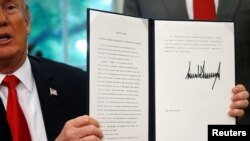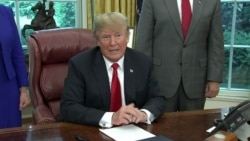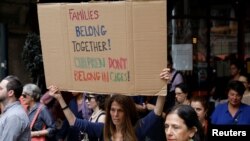Following days of fierce global criticism, President Donald Trump signed an executive order to end his policy of family separations along the U.S.-Mexico border.
Trump signed the order Wednesday, saying he “didn’t like the sight or the feeling of families being separated.”
WATCH: Trump signs executive order
Lawmakers had called for Trump to take unilateral action to end the policy instituted in April that resulted in more than 2,300 children being separated from their parents.
The move reflects the enormous political pressure put on Trump.
Images of children in metal cages and audio of them crying for their parents had prompted global outrage.
What does the executive order do?
Under the new U.S. policy, parents and children caught crossing the border illegally will be kept together at federal detention centers for the length of their criminal proceedings.
Doesn’t that solve the issue of family separations?
Not exactly. Because of a 1997 federal court decision known as the Flores settlement, the government cannot hold children in custody for more than 20 days. That’s a problem, since most illegal entry criminal proceedings take much longer than that. As part of the executive order, Trump is appealing to the U.S. District Court to overturn the Flores settlement, allowing immigrant families to be detained indefinitely.
What happens if the court refuses to overturn the Flores settlement?
It’s not clear. And to make things even more uncertain, some analysts say the attempt to modify the court ruling will be unsuccessful. If the federal government flouted the ruling and continued to detain children for longer than 20 days, a major court challenge could ensue. It’s not clear how long that challenge would take, or what would happen to the immigrant detainees in the meantime.
Where will the immigrant families be detained?
Because federal immigrant detention centers are not thought to be large enough to hold all of the new detainees, the Trump executive order calls on the U.S. military to provide any existing facilities, and construct more facilities if necessary, to house detainees.
Asked about the issue Wednesday, U.S. Defense Secretary Jim Mattis said he would “respond, if requested,” adding, “We have housed refugees. We have housed people thrown out of their homes by earthquakes and hurricanes. We do whatever is in the best interest of the country.”
Presumably in an effort to clear detention space, the order also calls for courts to “prioritize the adjudication of cases involving detained families.”
Didn’t top White House officials say there was nothing he could do about the child separations?
Yes. Trump and many of his top officials insisted for days that the president lacked the ability to unilaterally end family separations at the border, instead arguing that congressional action was necessary. Specifically, Trump had demanded legislative action on his broad immigration agenda, including funding for a border wall and a move toward what he said was a “merit-based” system of immigration.
Where does congressional action stand?
Republicans had been working on two separate bills in the House of Representatives to address the issue, but as of early Wednesday they appeared to lack the votes necessary to pass the bills.








